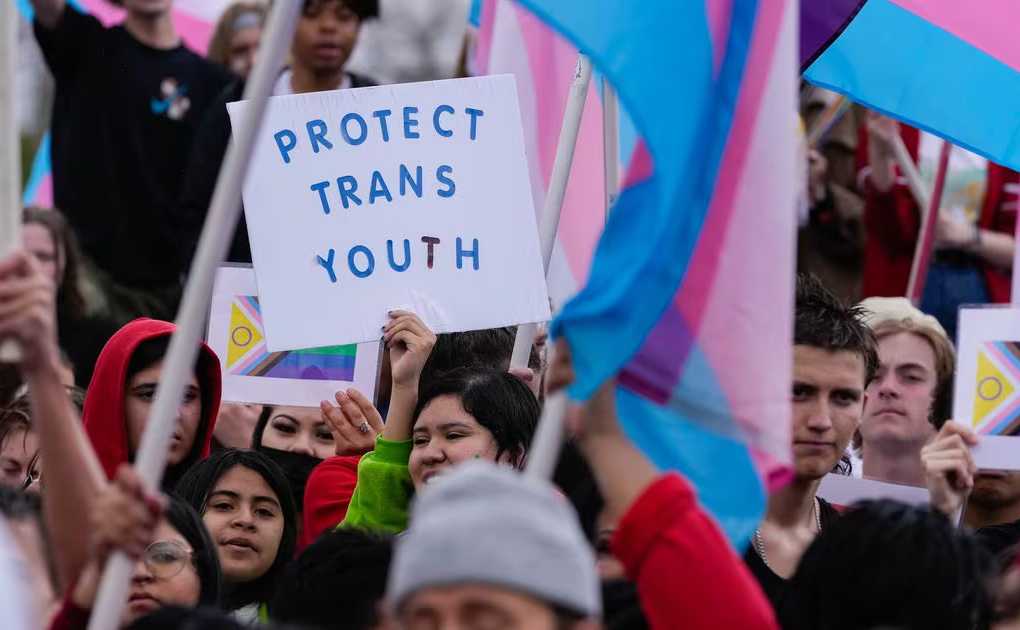
More Utahns are seeking health care to help embrace their gender identity, even as the state lawmakers have limited access to services and continue to target transgender people.
Every state but South Dakota had more people diagnosed with gender dysphoria in 2022 than in 2018, according to a Definitive Healthcare report.
“Our medical claims data shows that gender dysphoria diagnoses are on the rise, and patients with these diagnoses are seeking mental health services in greater numbers than ever,” the report reads.
A gender dysphoria diagnosis does not necessarily mean someone is transgender, and not all people who identify as transgender have gender dysphoria. But the diagnosis does often precede a transition.
Utah had the third-highest increase of any state, with diagnoses nearly quadrupling in the time studied.
That means more Utahns sought gender-affirming care in the years leading up to the state banning that care for youth last year, pending a study of impacts, and more bills this legislative session that target transgender people.
About 1.3 million Americans identified as transgender in June 2022, according to the Williams Institute at the UCLA School of Law.
That number includes an estimated 2,100 Utahns between the ages of 13 and 17, and an estimated 13,700 Utah adults.
“Transgender” is a broad term for people whose gender identity or expression differs from the sex they were assigned at birth.
Before transitioning, many transgender people experience gender dysphoria, a type of psychological distress arising from the perceived disconnect between their assigned sex and gender identity.
While gender dysphoria and identifying as transgender are not synonymous, a diagnosis is often the first step when seeking gender-related mental health care or gender-affirming care to access treatment and activate insurance coverage.
Definitive Healthcare spent three months analyzing medical procedure and diagnosis claims data from several sources, including the company’s own products, the NPI registry and proprietary research. The analysis showed that “more people than ever are seeking gender-affirming care, even while access to that care is being intentionally and systemically limited.”
Gender dysphoria diagnoses increased between 6% and 274% in every state but South Dakota, which had a 23% decrease.
Utah had the third-highest increase at 193%, much higher than the national average increase of 100%. At almost 200%, that means diagnoses nearly quadrupled from 2018 to 2022. Only Virginia and Indiana had bigger increases.
The report doesn’t explicitly state why these increases are happening but does note that conversations around gender identity and expression more broadly are becoming “more accepted by society.”
The report also notes year-to-year changes in some states as “shifting social and political climates” push patients to seek diagnoses in nearby states.
South Dakota’s drop links to the “chilling effects of reduced access to sympathetic providers” following failed attempts to restrict gender-affirming care in 2020 before legislators passed a measure that did so in February 2023. The report does not address whether a similar chilling effect could happen in Utah.
Transgender patients’ access to care has received heightened national attention in recent years as the LGBTQ community’s work to promote visibility and equality has been met with legislative efforts to limit or ban trans-specific care services in nearly half of U.S. states.
As of December, 22 states had banned gender-affirming care for youth in some way. Utah is one of them.
That’s in addition to other barriers.
For example, a recent KFF survey of state Medicaid programs found that only two of the survey’s 41 respondents cover all gender-affirming health care services, from hormone therapy and surgery to mental health counseling.
That study found that as of July 1, 2021, Utah’s Medicaid program covered gender-affirming surgery, gender-affirming hormone therapy and behavioral health — but not voice and communication therapy or fertility services.
Though more people than ever have sought gender-affirming care in recent years, states — including Utah — continue to consider bills targeting transgender residents.
As of last week, the American Civil Liberties Union was tracking close to 300 bills targeting LGBTQ rights nationwide, including three in Utah.
One receiving a particular amount of criticism would change the legal definitions of “female” and “male” to exclude transgender people.
The bill, sponsored by Rep. Kera Birkeland, R-Morgan, and titled “Sex-based Designations for Privacy, Anti-bullying and Women’s Opportunities,” or HB257, also would bar transgender people from entering sex-specific spaces, such as public bathrooms. The bill passed the House last week, and was passed out of the Senate Business and Labor Committee on Monday.
The other bills the ACLU is tracking in Utah are HB253 and HB303.
HB253 would prohibit transgender people from using restrooms, locker rooms and changing rooms in Utah’s K-12 schools and higher education institutions that align with their gender identity. HB303 would prohibit school officials and employees from discussing political beliefs, including viewpoints on sexual orientation and gender identity.
While legislators make laws that “enshrine access to medical care,” anyone can “take steps to make their corner of the world more welcoming and improve awareness,” the Definitive Healthcare report reads.
The report poses potential actions for:
-
Citizens: Lobby representatives and be active through rallies, testimony and other avenues to demand change
-
Doctors in states without access: Direct patients to resources or find ways to deliver necessary care.
-
People in less restrictive states: Open their doors to patients seeking care away from home.
Megan Banta is The Salt Lake Tribune’s data enterprise reporter, a philanthropically supported position. The Tribune retains control over all editorial decisions.



